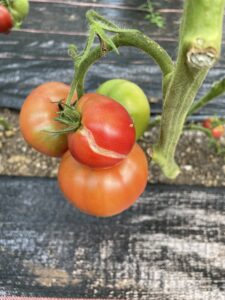Tomatoes cracking in the late stages of ripening (Figure 1) was observed in our field visit. This article discusses conditions that are likely to predispose tomatoes to crack.
The cracking that happened recently in open field production is likely associated with the heavy rains. The problem is most observed when a dry period is followed by heavy rains. The change from low to high soil moisture reduced the tomato skin strength, and as the fruit expanded quickly, cracking occurred. High soil moisture due to rains and overhead irrigation is even more likely to cause fruit cracking than drip irrigation. This is because water can directly enter the fruit through tiny cracks that may have occurred before large cracks become visible. High temperature and high light also predispose tomatoes to cracking. This is because rising temperatures of fruit pulp increase the pressure on the skin while it also decreases skin strength.
Cracking is not confined to tomatoes growing in open-field; it happens on tomatoes growing in high tunnels and greenhouses, in spite of the fact that soil moisture is often maintained at a more consistent level under protected production. High relative humidity is one of the reasons that may predispose fruit to crack in greenhouses. Transpiration is high under low relative humidity, thus water may move back from fruit to leaves. But this is unlikely to happen when relative humidity is high and when soil is moist. So when water pressures increase in fruit because of temperature increase or an increase in water supply, the skin is exposed to high internal pressure that may eventually cause cracking. Applying shading to the tunnels can reduce fruit cracking as well as other high-temperature-related tomato disorders, such as yellow shoulder and blotchy ripening. However, be aware that shading reduces the light intensity, over-applying or applying shading for an extended period decreases photosynthesis that can negatively affect yield and quality.
Growers note that cracking rarely happens on small-sized tomatoes. It is true that fruit size makes a difference. As fruit increases in size, physical stresses on skins increase that predispose fruit to cracking. Another interesting observation is that cracking is more likely to happen on plants that have a smaller number of fruit. Because of the lack of competition for carbohydrates and water, those fruits often grow rapidly and that increases the chance to crack.
Cultivar differences in susceptibility to cracking clearly exist. From a plant physiology standpoint, the tolerant cultivars may have tougher skin at the turning stage or smaller fruit size. It could also be because of plant architecture, for example, more vegetative growth that shades the fruit.
Cracking reduces fruit marketability and makes them prone to rot. One last piece of information, hoping to make growers who are struggling with the tomato cracking issues feel a little better, cracked tomatoes often have high soluble-solids content. Water tends to move from an area of plant that has a lower sugar concentration to a higher concentration. Thus, the higher the fruit sugar concentration, the greater tendency that water moves into the fruit that increases pressure to the skin.
